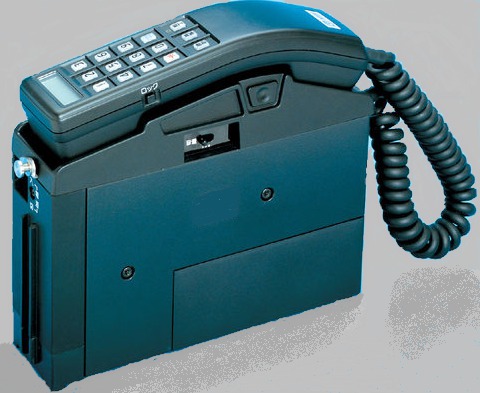What's 5G? Vol.1. Let us explain about the flow and features from 1G to 2G
What is 5G? Many of you know that it is the name of the mobile network generation and means the 5th generation (hereinafter abbreviated as 5G).
Smartphones have already become an indispensable tool in daily life, but the it was car phone basically.
The starting point may be forgotten as each generation continues to evolve.
The first generation (1st Generation, hereinafter abbreviated as 1G) started domestic service around 1980.
The early model was an analog system and was a large in-vehicle device. Basically it was in-vehicle, but there was also a type that can be used as a mobile phone
if you carry the main body like a shoulder bag. However, because the battery was not lithium-ion as it is now,
it was heavy and we didn't feel like carrying it around easily. Also, the call charges were very high and it was like being used by corporate executives in a company-owned car.
After that, mobile phones with thicker handsets appeared, but the call charges did not drop and they did not spread and were only used by a limited number of users.
I have no experience using mobile phones of this era and I do not know the call quality. However, it seems that the call quality was considerably poor and it was difficult to hear.
It was heavy, expensive, and hard to hear, but it's easy to imagine that there was a certain amount of demand. It's a situation we can't imagine now.
By the way, the communication method was different not only internationally but also domestically, and it was different in each country and each carrier. 1G is a retrofit name.
At that time, it would not have been imagined that it would evolve as it is today.

The 2nd Generation (hereinafter abbreviated as 2G) was launched in 1993. Digital methods have been adopted for 2G,
and the size of the terminal has been reduced to the point where it can be carried. It's a so-called Galapagos mobile phone (feature phone).
It was around the time of 2G that terminals became cheaper and became popular. Although it was cheap, it was not cheap as a telephone,
but at that time, it became popular because it was possible to sell the terminal to virtually zero if a long-term call charge contract was signed.
Call quality was unsatisfactory, and calls inside the vehicle were often inaudible due to ambient noise. By the way, at that time,
calls in the vehicle were possible even though it was looked coldly at. Also, disconnections during the call occurred frequently.
Especially in high places (high floors of buildings, etc.) that receive radio waves from multiple base stations at the same time,
I remember that disconnections occurred frequently. In addition, the radio wave condition changed drastically depending on the location,
and I searched for a location where quality could be ensured and avoided disconnection with an immovable posture like a mannequin.
At docomo (at that time NTT DoCoMo), adding the acronym of the terminal manufacturer, Mova N (NEC), Mova F (Fujitsu), Mova D (Mitsubishi Electric),
Mova M (Motorora), Mova P (Panasonic at that time Matsushita), Mova R (Japan Radio), etc., Mova P was hard to disconnect,
and Mova N introduced a "bi-fold" terminal that other companies did not have, which influenced the popularity of the manufacturer.
It was also a time when the hinges were broken due to the lack of durability of the "bi-fold" terminal, and the superiority and inferiority between manufacturers became clear.
By the way, the manufacturer assumed that the destruction of this hinge would open and close the "folded" terminal only during a call,
but it did not consider the behavior that young people shake the terminal and repeat opening and closing when they have nothing special to do.
Because of that, it was the cause. After that, SH (Sharp), SO (Sony), SA (Sanyo Electric), ER (Ericsson), NM (Nokia), etc. were added,
and the choice of terminals increased.
Also, in 2G, domestic communication methods were unified, but Japanese terminals could not be used overseas.
Originally, the communication method was divided into the United States, Japan and other countries, and the mobile network was also divided into D-AMPS (US),
PDC (Japan) and GSM (other countries). At that time, terminals could be used for SIM exchange outside Japan and the United States,
but Japanese had no choice but to rent a terminal at Narita Airport or buy a terminal locally. Outside of Japan and the United States,
Nokia made in Finland was popular and boasted a high market share, but in Japan and the United States, the market share of domestic manufacturers was high.
In addition, PHS (Personal Handy-phone System) became widespread at the same time as 2G. This is intended to carry a landline phone like a cordless phone,
and because the base station was very easy and cheap compared to a mobile phone, it was hard to cut and the call quality was good.
It became popular with a momentum that surpassed that of mobile phones. On the other hand, it could not be used while traveling by rail or car,
and at that time, it was forced to reduce the service because it could not get on the flow of i-mode equipped with Internet connection and mail function
from terminals that began to spread at that time. However, since the Internet connection and mail functions in the 2G era were billed only for the amount
used by pay-as-you-go, high call charges in i-mode had also become a problem. Eventually, PHS has finished its role.
